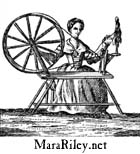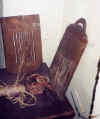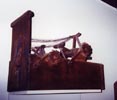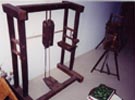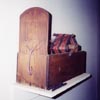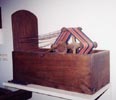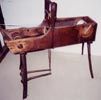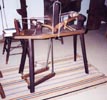| A Gallery of Tape Looms | |
|
Tape Looms and Woven Tapes Woven tape was used for items such as garters, apron strings, belts, ties for pillow bolsters, straps for powder horns or hunting pouches, carpet binding, trim for women's pockets, ties for seed or grain bags, loops for hanging up towels -- the list goes on and on. It was generally woven at home, but sometimes was available for sale from rural stores (Gehret 239) or from beggars (OED). A Word About Inkle Looms The modern inkle loom was designed in 1924 by the Industrial Arts Cooperative Service (later known as Artcraft). I've heard people at reenacting events claim an older provenance for this style of loom, but these claims are spurious. That being said, modern inkle looms weave tape in the same way that older-style rigid-heddle looms do, except that they use string heddles to change the shed, making them easier to manufacture than a rigid heddle loom. The tape woven on inkle looms is not necessarily "wrong" for 18th century reenacting; the loom itself, however, is not appropriate to the period and should not be brought to events. Pictures of Period Tape Looms |
|
|
Tape looms from the Landis
Valley Farm Museum, a museum that documents Pennsylvania German
culture and history: Also see: tape loom in collection of Pocumtuck Valley Memorial Association, Deerfield MA More info and pics at Tapelooms.com |
|
Recommended Reading Neher, Evelyn, Inkle -- has pictures of tape and tape looms from the middle ages through modern times, as well as pictures and descriptions of people using the looms Gehret, Ellen J., Rural Pennsylvania Clothing -- includes 6 pages of pictures and descriptions of 18th / early 19th century linen tapes Weidert, Bonnie R., Tape Looms Past and Present -- nice survey of the subject, includes pictures of period looms, plans for making a loom, directions for setting it up, and weaving drafts Weaver, Susan Faulkner: Handwoven Tape: Understanding and Weaving Early American and Contemporary Tape |
|
|
|
|
|
|
|
